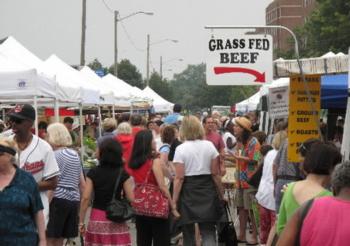Selling Meat at Farmers Markets
On this page:
Information specific to selling meat at Certified Farmers Markets. In order to be eligible to sell at farmers markets, the meat must be processed, labeled and stored as outlined in Selling Locally Grown Meat.
Certified Farmers’ Market means a location certified by the County Agricultural Commissioner and operated pursuant to the Food and Agricultural Code and regulations. There are often two sections to farmers markets:
- 'certified' section where agricultural produce and agricultural products grown by the seller are sold
- 'community' section where other items such as drinks, food and crafts are sold.

Certified Agricultural Products means agricultural products, which are certified under the jurisdiction of the county agricultural commissioner and include fresh fruits, nuts, vegetables, herbs, shell eggs, honey, flowers, and nursery stock, and farmed mushrooms. All products must be listed on their Certified Producer Certificate (CPC). To learn more about these products, see Selling Produce at Farmers Markets.
Non-Certifiable Agricultural Products include agricultural value-add foods, livestock and dairy products and may be sold in the Certified section of the market when they meet the following requirements:
- Value-added food products made from agricultural produce grown by the seller listed on their CPC.
Note: the following additional requirements are ever changing:- Contain a limited number of ingredients or additives which act only as preservatives or are essential, like pectin for jelly and are granular
- Products must be made in a facility with a health permit (e.g. Cottage Food Facility, Processed Food Registration)
- Ingredients which are not essential, such as onion, apples, etc. must also be grown by the producer
- Red meat: livestock must have been owned by the seller. Must be processed and packaged in a USDA facility*
- The meat must be stored in a registered facility USDA form 5020-1 Meat and Poultry Handler Registration (this registration is free)
- Poultry/Rabbit meat: must have been raised by seller and processed by an approved source, refer to Selling Locally Grown Meat, Table 2*
- Dairy products must come from stock owned by seller and processed and stored in a CDFA licensed facility
If the agricultural products do not meet requirements 1-4 above, the products must be sold in the 'community' section of the market.
*NOTE: Ranchers who raise their own livestock/poultry/rabbits and sell meat from these animals, may sell in the certified section of the farmers market as long as they meet the criteria above.
If the seller is also selling meat from livestock raised by another or meat products (e.g. sausage, cured meats) that do not meet the criteria listed above, they must sell in the 'community' section of the farmers market.
Table 1 examples of the section of the market where non-certifiable ag products are sold:
| Products and Ingredients |
Section of Market |
| Raw/seasoned/processed meat and sauce made with meat, fresh onions, garlic and basil - ALL ingredients used were raised/grown by seller (other ingredients allowed are granular only) |
Certified |
| Raw/seasoned/processed meat and sauce made with meat, fresh onions, garlic and basil - NOT ALL ingredients raised/grown by seller |
Community |
| Sausage made from livestock raised by seller, seasoned with powdered ingredients | Certified |
| Sausage made from livestock raised by seller, seasoned with fresh ingredients NOT grown by seller | Community |
Note: All value add meat products must be made in proper facilities. See Meat Products.
Food Facility Permit
A Temporary Food Facility Permit must be obtained if:
- Sellers offer samples
- Sellers who sell food products in the 'community' section
Contact Sonoma County Environmental Health & Safety at eh@sonoma-county.org or (707) 565-6565 for the current cost of a permit.
This information is summarized in Table 2 below.
Load Lists
The Load List is an itemized list of all products sold at the CFM each market day which states the name of the certified producer, the identity of each product sold as it appears on the certified producer’s certificate, and the quantity of each product sold at the market.
If the rancher is selling in the 'certified' section, they must provide a Load List to the Market Manager at the end of the day. The Load List’s are created by the market managers. It is suggested that the Load List for meat show sales by species (e.g. beef, lamb, pork), total quantity brought to the market and total quantity sold and total revenue (e.g. XXlbs of lamb, total sales of $XXX.XX).
Table 2 summarizes when a Food Facility Permit or Load List is required.
| Source of Meat |
Raised by seller only and meet criteria 1-8 above | Selling meat from livestock not raised by seller and/or meat products that don't meet criteria 1-4 listed above |
| Section of Market allowed to be sold |
Certified | Community |
| Food Facility Permit | Not Required | Required |
| Offering Tastings: Food Facility Permit | Required | Required |
| Load List | Required | Not Required |
Collaboration
This fact sheet was reviewed for accuracy by Sonoma County Department of Health Services and Sonoma County Agriculture Department, July 2016.